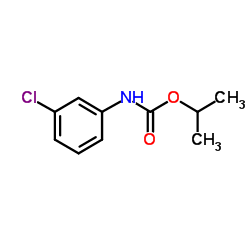Mechanisms of the thermal decay of chlorpropham.
Margaret J Smith, Sandra Müller, Wolfram Sander, Götz Bucher
文献索引:J. Hazard. Mater. 246-247 , 154-62, (2013)
全文:HTML全文
摘要
DFT calculations were performed on the thermal reactions of chlorpropham 1, a carbamate pesticide and plant growth regulator frequently used in the storage of potatoes. At the conditions normally used in applying 1 (injection of a methanolic solution of 1 into a hot air stream, T ≈ 500°C), both ester pyrolysis of 1 and a methanol-or water-catalysed isocyanate cleavage are expected to proceed rapidly (lifetime of 1 less than a second). In both reactions, the final reaction product will be toxic and carcinogenic m-chloroaniline 2. Matrix-isolation experiments indicate that 1 undergoes thermal decay at temperatures as low as 250°C. Up to temperatures of ca. 500°C, formation of m-chlorophenylisocyanate 4 and isopropanol was the predominant reaction observed, while formation of propene, CO(2), and m-chloroaniline 2 was the most important reaction channel at higher pyrolysis temperatures. m-Chlorophenyl carbamic acid 3 could not be observed. The results indicate that at lower temperatures, 1 decays exclusively via isocyanate cleavage of 1, provided that traces of catalytic water or other protic compounds are present. At higher temperatures, ester cleavage of 1 becomes competitive and outweighs the isocyanate cleavage by a factor of ca. 10:1.Copyright © 2012 Elsevier B.V. All rights reserved.
相关化合物
| 结构式 | 名称/CAS号 | 分子式 | 全部文献 |
|---|---|---|---|
 |
氯苯胺灵
CAS:101-21-3 |
C10H12ClNO2 |
|
[Survey of pesticide residues in imported frozen vegetables ...
2011-01-01 [Shokuhin Eiseigaku Zasshi 52(2) , 121-9, (2011)] |
|
Mining biologically-active molecules for inhibitors of fatty...
2009-01-01 [Bioorg. Med. Chem. Lett. 19 , 6793-6, (2009)] |
|
The sprout inhibitors chlorpropham and 1,4-dimethylnaphthale...
2010-05-01 [Plant Mol. Biol. 73(1-2) , 181-9, (2010)] |
|
Rapid determination of aniline metabolites of chlorpropham i...
2005-08-01 [Electrophoresis 26(15) , 2991-8, (2005)] |
|
Planktonic versus biofilm catabolic communities: importance ...
2011-07-01 [Appl. Environ. Microbiol. 77(14) , 4728-35, (2011)] |